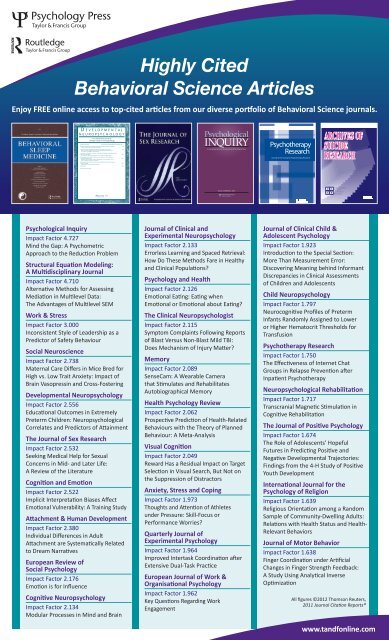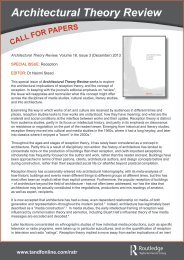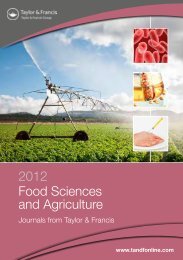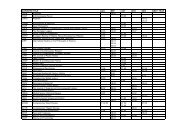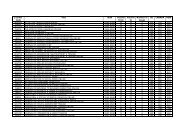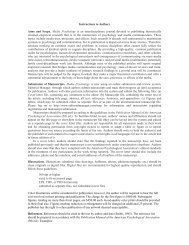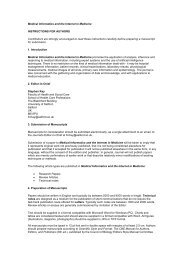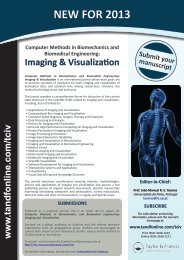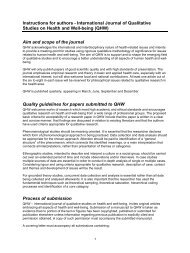Highly Cited Behavioral Science Articles
Highly Cited Behavioral Science Articles
Highly Cited Behavioral Science Articles
You also want an ePaper? Increase the reach of your titles
YUMPU automatically turns print PDFs into web optimized ePapers that Google loves.
<strong>Highly</strong> <strong>Cited</strong><br />
<strong>Behavioral</strong> <strong>Science</strong> <strong>Articles</strong><br />
Enjoy FREE online access to top-cited articles from our diverse portfolio of <strong>Behavioral</strong> <strong>Science</strong> journals.<br />
Psychological Inquiry<br />
Impact Factor 4.727<br />
Mind the Gap: A Psychometric<br />
Approach to the Reduction Problem<br />
Structural Equation Modeling:<br />
A Multidisciplinary Journal<br />
Impact Factor 4.710<br />
Alternative Methods for Assessing<br />
Mediation in Multilevel Data:<br />
The Advantages of Multilevel SEM<br />
Work & Stress<br />
Impact Factor 3.000<br />
Inconsistent Style of Leadership as a<br />
Predictor of Safety Behaviour<br />
Social Neuroscience<br />
Impact Factor 2.738<br />
Maternal Care Differs in Mice Bred for<br />
High vs. Low Trait Anxiety: Impact of<br />
Brain Vasopressin and Cross-Fostering<br />
Developmental Neuropsychology<br />
Impact Factor 2.556<br />
Educational Outcomes in Extremely<br />
Preterm Children: Neuropsychological<br />
Correlates and Predictors of Attainment<br />
The Journal of Sex Research<br />
Impact Factor 2.532<br />
Seeking Medical Help for Sexual<br />
Concerns in Mid- and Later Life:<br />
A Review of the Literature<br />
Cognition and Emotion<br />
Impact Factor 2.522<br />
Implicit Interpretation Biases Affect<br />
Emotional Vulnerability: A Training Study<br />
Attachment & Human Development<br />
Impact Factor 2.380<br />
Individual Differences in Adult<br />
Attachment are Systematically Related<br />
to Dream Narratives<br />
European Review of<br />
Social Psychology<br />
Impact Factor 2.176<br />
Emotion is for Influence<br />
Cognitive Neuropsychology<br />
Impact Factor 2.134<br />
Modular Processes in Mind and Brain<br />
Journal of Clinical and<br />
Experimental Neuropsychology<br />
Impact Factor 2.133<br />
Errorless Learning and Spaced Retrieval:<br />
How Do These Methods Fare in Healthy<br />
and Clinical Populations?<br />
Psychology and Health<br />
Impact Factor 2.126<br />
Emotional Eating: Eating when<br />
Emotional or Emotional about Eating?<br />
The Clinical Neuropsychologist<br />
Impact Factor 2.115<br />
Symptom Complaints Following Reports<br />
of Blast Versus Non-Blast Mild TBI:<br />
Does Mechanism of Injury Matter?<br />
Memory<br />
Impact Factor 2.089<br />
SenseCam: A Wearable Camera<br />
that Stimulates and Rehabilitates<br />
Autobiographical Memory<br />
Health Psychology Review<br />
Impact Factor 2.062<br />
Prospective Prediction of Health-Related<br />
Behaviours with the Theory of Planned<br />
Behaviour: A Meta-Analysis<br />
Visual Cognition<br />
Impact Factor 2.049<br />
Reward Has a Residual Impact on Target<br />
Selection in Visual Search, But Not on<br />
the Suppression of Distractors<br />
Anxiety, Stress and Coping<br />
Impact Factor 1.973<br />
Thoughts and Attention of Athletes<br />
under Pressure: Skill-Focus or<br />
Performance Worries?<br />
Quarterly Journal of<br />
Experimental Psychology<br />
Impact Factor 1.964<br />
Improved Intertask Coordination after<br />
Extensive Dual-Task Practice<br />
European Journal of Work &<br />
Organisational Psychology<br />
Impact Factor 1.962<br />
Key Questions Regarding Work<br />
Engagement<br />
Journal of Clinical Child &<br />
Adolescent Psychology<br />
Impact Factor 1.923<br />
Introduction to the Special Section:<br />
More Than Measurement Error:<br />
Discovering Meaning behind Informant<br />
Discrepancies in Clinical Assessments<br />
of Children and Adolescents<br />
Child Neuropsychology<br />
Impact Factor 1.797<br />
Neurocognitive Profiles of Preterm<br />
Infants Randomly Assigned to Lower<br />
or Higher Hematocrit Thresholds for<br />
Transfusion<br />
Psychotherapy Research<br />
Impact Factor 1.750<br />
The Effectiveness of Internet Chat<br />
Groups in Relapse Prevention after<br />
Inpatient Psychotherapy<br />
Neuropsychological Rehabilitation<br />
Impact Factor 1.717<br />
Transcranial Magnetic Stimulation in<br />
Cognitive Rehabilitation<br />
The Journal of Positive Psychology<br />
Impact Factor 1.674<br />
The Role of Adolescents’ Hopeful<br />
Futures in Predicting Positive and<br />
Negative Developmental Trajectories:<br />
Findings from the 4-H Study of Positive<br />
Youth Development<br />
International Journal for the<br />
Psychology of Religion<br />
Impact Factor 1.639<br />
Religious Orientation among a Random<br />
Sample of Community-Dwelling Adults:<br />
Relations with Health Status and Health-<br />
Relevant Behaviors<br />
Journal of Motor Behavior<br />
Impact Factor 1.638<br />
Finger Coordination under Artificial<br />
Changes in Finger Strength Feedback:<br />
A Study Using Analytical Inverse<br />
Optimization<br />
All figures ©2012 Thomson Reuters,<br />
2011 Journal Citation Reports®<br />
www.tandfonline.com
Research in Human Development<br />
Impact Factor 1.633<br />
Developmental Systems <strong>Science</strong>:<br />
Exploring the Application of Systems<br />
<strong>Science</strong> Methods to Developmental<br />
<strong>Science</strong> Questions<br />
<strong>Behavioral</strong> Sleep Medicine<br />
Impact Factor 1.553<br />
The Impact of Educational Message<br />
Framing on Adherence to Continuous<br />
Positive Airway Pressure Therapy<br />
Journal of Applied Sport Psychology<br />
Impact Factor 1.547<br />
The Relationship between Imagery<br />
Ability and Imagery Use among Athletes<br />
Language and Cognitive Processes<br />
Impact Factor 1.538<br />
Is Morpho-Orthographic Decomposition<br />
Purely Orthographic? Evidence from<br />
Masked Priming in the Same–Different<br />
Task<br />
Archives of Suicide Research<br />
Impact Factor 1.530<br />
Sex and Emotion in the Acquired<br />
Capability for Suicide<br />
International Journal of<br />
Clinical and Experimental Hypnosis<br />
Impact Factor 1.52<br />
A Stranger in the Looking Glass:<br />
Developing and Challenging a Hypnotic<br />
Mirrored-Self Misidentification Delusion<br />
Self and Identity<br />
Impact Factor 1.417<br />
Conflicts of Interest: Relational<br />
Self-Construal and Decision Making<br />
in Interpersonal Contexts<br />
Multivariate <strong>Behavioral</strong> Research<br />
Impact Factor 1.412<br />
Bias in Cross-Sectional Analyses<br />
of Longitudinal Mediation: Partial<br />
and Complete Mediation under an<br />
Autoregressive Model<br />
Aging & Mental Health<br />
Impact Factor 1.368<br />
Sociodemographic Predictors of Elderly’s<br />
Psychological Well-Being in Malaysia<br />
Aphasiology<br />
Impact Factor 1.317<br />
Recent Developments in Functional and<br />
Structural Imaging of Aphasia Recovery<br />
after Stroke<br />
Experimental Aging Research<br />
Impact Factor 1.306<br />
How Arousal Affects Younger and<br />
Older Adults’ Memory Binding<br />
Journal of Personality Assessment<br />
Impact Factor 1.287<br />
Toward a Model for Assessing Level<br />
of Personality Functioning in DSM–5,<br />
Part I: A Review of Theory and Methods<br />
Journal of Sex & Marital Therapy<br />
Impact Factor 1.273<br />
Evaluation of Sexual Function in<br />
Brazilian Pregnant Women<br />
Journal of Trauma & Dissociation<br />
Impact Factor 1.231<br />
Guidelines for Treating Dissociative<br />
Identity Disorder in Adults, Third<br />
Revision: A Tour de Force for the<br />
Dissociation Field<br />
Journal of Organizational<br />
Behavior Management<br />
Impact Factor 1.229<br />
Managing Performance to Change<br />
Behavior<br />
Ecological Psychology<br />
Impact Factor 1.188<br />
On Potential-Based and Direct<br />
Movements in Information Spaces<br />
Psychology, Health & Medicine<br />
Impact Factor 1.178<br />
Association between Morningness–<br />
Eveningness and Mental and Physical<br />
Health in Adolescents<br />
Applied Neuropsychology: Adult<br />
Impact Factor 1.173<br />
Comparison between the Test of<br />
Memory Malingering (TOMM) and<br />
the Nonverbal Medical Symptom<br />
Validity Test (NV-MSVT) in Adults<br />
with Disability Claims<br />
<strong>Behavioral</strong> Medicine<br />
Impact Factor 1.143<br />
Fear of Progression in Partners<br />
of Chronically Ill Patients<br />
Laterality: Asymmetries of<br />
Body, Brain and Cognition<br />
Impact Factor 1.135<br />
Digit Ratio (2D:4D), Salivary<br />
Testosterone, and Handedness<br />
Parenting: <strong>Science</strong> and Practice<br />
Impact Factor 1.133<br />
Parenting Attributions and Attitudes in<br />
Diverse Cultural Contexts: Introduction<br />
to the Special Issue<br />
Thinking and Reasoning<br />
Impact Factor 1.118<br />
Truth Table Tasks: Irrelevance and<br />
Cognitive Ability<br />
Neurocase<br />
Impact Factor 1.114<br />
Are Mirror Neurons the Basis of Speech<br />
Perception? Evidence from Five Cases<br />
with Damage to the Purported Human<br />
Mirror System<br />
Language Acquisition<br />
Impact Factor 1.095<br />
Early Word Order Representations: Novel<br />
Arguments against Old Contradictions<br />
Journal of Cognitive Psychology<br />
Impact Factor 1.090<br />
Electrophysiological Evidence of<br />
Emotion Perception without Central<br />
Attention<br />
Journal of Cognition<br />
and Development<br />
Impact Factor 1.079<br />
Executive Function in Preschool<br />
Children: Test–Retest Reliability<br />
Aging, Neuropsychology,<br />
and Cognition<br />
Impact Factor 1.073<br />
Agnosic or Semantic Impairment in<br />
Very Mild Alzheimer’s Disease?<br />
The Journal of General Psychology<br />
Impact Factor 1.043<br />
Multiple Trials May Yield Exaggerated<br />
Effect Size Estimates<br />
Journal of Loss & Trauma<br />
Impact Factor 1.032<br />
Development, Use, and Psychometric<br />
Properties of the Trauma History<br />
Questionnaire<br />
All figures ©2012 Thomson Reuters,<br />
2011 Journal Citation Reports®<br />
www.tandf.co.uk/journals/cited/<strong>Behavioral</strong>2012.pdf<br />
For a complete list of related books and journals<br />
published by Routledge and Psychology Press,<br />
visit the following:<br />
Routledge Mental Health Arena<br />
www.routledgementalhealth.com<br />
Psychology Press<br />
www.psypress.com<br />
‘Like’ us on !<br />
www.facebook.com/RoutledgeMentalHealth<br />
www.facebook.com/PsychologyPress<br />
Follow us on !<br />
www.twitter.com/routledgemh<br />
www.twitter.com/psypress<br />
www.tandfonline.com


